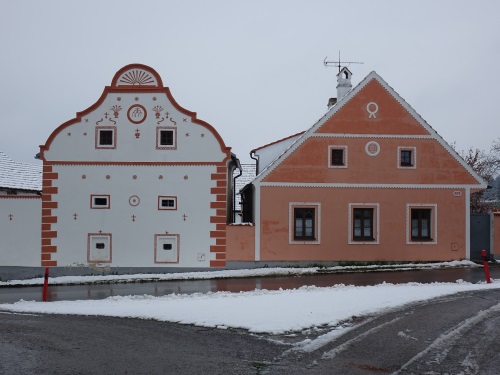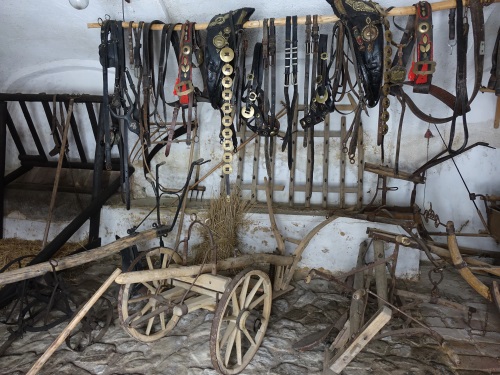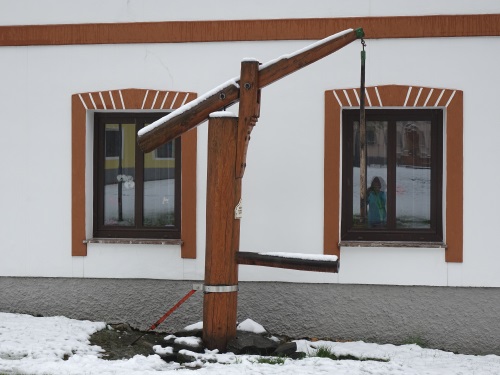Blog WHS Visits
WHS #630: Holasovice
Holašovice Historic Village is a tiny WHS in the south of Czechia. Six previous reviewers on this website have already tried to capture its Outstanding Universal Value - often in vain. Its value lies in its architecture (the fusion of two vernacular building traditions into "South Bohemian Folk Baroque") and being an authentic representation of a Central European rural settlement. It also has been considered as a continuing cultural landscape, but that part seems to have been disregarded at inscription.
 Less than a week after I was in Egypt, with temperatures reaching 40 degrees Celsius in Abu Simbel, I found myself at a completely different scene. Holašovice lies in a hilly area full of farm villages. There was still snow on the ground. The closer I got to Holašovice the snow cover got thicker and it started raining as well. I had some trouble finding the town actually – I had to navigate via my smartphone, as there is no signposting. On the way I passed at least two village centers similar to Holašovice, with a pond and a row of colourful houses.
Despite its unassuming surroundings, Holašovice is ready to receive tourists. At the edge of town there’s a parking lot large enough for a tour bus or 2. They also have an information center and a museum. And a monument celebrating the inscription on the World Heritage List. A minibus with some Asian tourists was just leaving when I arrived – the last passengers were running around to have some quick final shots of the village.
Less than a week after I was in Egypt, with temperatures reaching 40 degrees Celsius in Abu Simbel, I found myself at a completely different scene. Holašovice lies in a hilly area full of farm villages. There was still snow on the ground. The closer I got to Holašovice the snow cover got thicker and it started raining as well. I had some trouble finding the town actually – I had to navigate via my smartphone, as there is no signposting. On the way I passed at least two village centers similar to Holašovice, with a pond and a row of colourful houses.
Despite its unassuming surroundings, Holašovice is ready to receive tourists. At the edge of town there’s a parking lot large enough for a tour bus or 2. They also have an information center and a museum. And a monument celebrating the inscription on the World Heritage List. A minibus with some Asian tourists was just leaving when I arrived – the last passengers were running around to have some quick final shots of the village.
 One of the characteristic spots in the village is the large pond in the center, but I could hardly see it because of the snow. All I could do was to take a brisk walk round the elongated square. Although the façades of the buildings that surround it have nice colours, they give away nothing about what lies behind their gates. None of the protected buildings except for the museum are open to the public. Which is understandable as people still live there. But it makes it hard to understand what exactly is so special about these farmhouses. If you want to prepare your visit in depth: more background info is available in this pocket guide.
Farmhouse number 6 holds the small "museum" - perhaps one could better say that the farmer exhibits his old items in a barn to earn something extra. Its opening hours may be erratic, but I was let in after ringing the bell. The owner of the house proceeded to give me an extensive explanation in English about each object. Later we talked about the weather ("this is not normal") and about the Netherlands (good country, he had been there a few years before). The biggest advantage of visiting this museum is that you can see how the traditional farmhouses are set up: through the gate you arrive at a courtyard, with to the left the house and behind it the stables and sheds.
One of the characteristic spots in the village is the large pond in the center, but I could hardly see it because of the snow. All I could do was to take a brisk walk round the elongated square. Although the façades of the buildings that surround it have nice colours, they give away nothing about what lies behind their gates. None of the protected buildings except for the museum are open to the public. Which is understandable as people still live there. But it makes it hard to understand what exactly is so special about these farmhouses. If you want to prepare your visit in depth: more background info is available in this pocket guide.
Farmhouse number 6 holds the small "museum" - perhaps one could better say that the farmer exhibits his old items in a barn to earn something extra. Its opening hours may be erratic, but I was let in after ringing the bell. The owner of the house proceeded to give me an extensive explanation in English about each object. Later we talked about the weather ("this is not normal") and about the Netherlands (good country, he had been there a few years before). The biggest advantage of visiting this museum is that you can see how the traditional farmhouses are set up: through the gate you arrive at a courtyard, with to the left the house and behind it the stables and sheds.
 In front of nearly every house stands a wooden pump, which was used to pump water by hand through pipes into the building. There might be some interesting piece of local history connected with the pumps, but I did not get to the bottom of it. Overall I lasted 25 minutes in town, my visit cut short because of the cold.
In front of nearly every house stands a wooden pump, which was used to pump water by hand through pipes into the building. There might be some interesting piece of local history connected with the pumps, but I did not get to the bottom of it. Overall I lasted 25 minutes in town, my visit cut short because of the cold.
Two of the facades
Museum exhibits
Water pump
Els - 6 May 2017